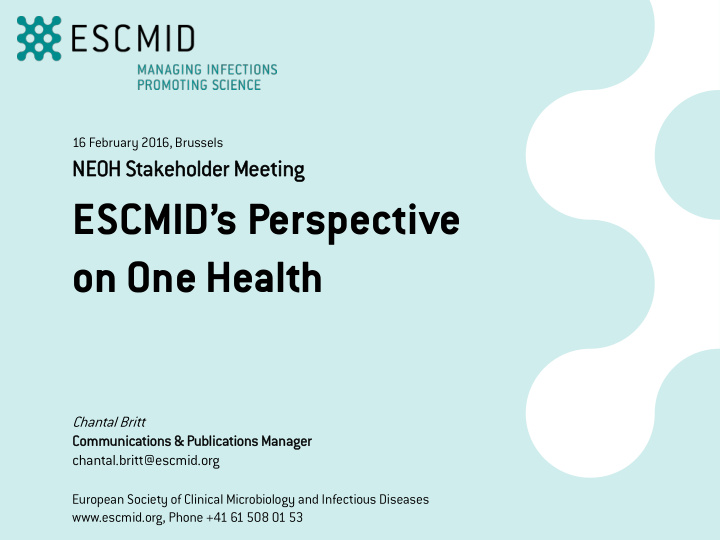



16 February 2016, Brussels NE NEOH H Stak akeholder Meet etin ing ESCMID’s Perspective on One Health Chantal Britt Co Commun unications s & Publications s Manager chantal.britt@escmid.org European Society of Clinical Microbiology and Infectious Diseases www.escmid.org, Phone +41 61 508 01 53
Two Partners in Cooperation Clinical l Microbiologis ists Infectious s Disease e Sp Specialis alists Scientific Affairs Education Publication Communication Professional Affairs www.escmid.org page 2
Facts & Figures ≈6,500 members, 55 affiliated societies with ≈ 40,000 members – Educational courses, workshops, conferences, summer school – Observerships, 81 centres on all continents, WHO, ECDC; mentorships – Trainee association, job platform, online library – Journals Clinical Microbiology and Infection , New Microbes New Infections www.escmid.org page 3
ESCMID congress ECCMID 25 th ECCMID in Copenhagen, April 2015: 10,671 participants from 112 countries (US, UK, Germany, Spain, France) More than 4,000 abstracts Next ECCMID in Amsterdam, 9-12 April 2016 NEOH present at Network Corner Several sessions on One Health (i.e. resistant gram-negative bacteria in animals and the environment or on zoonotic diseases) www.escmid.org page 4
Scientific Affairs & Projects – Medical guidelines – EUCAST – The European Committee on Antimicrobial Susceptibility Testing, vetCAST – National Antimicrobial Committees (NACs) – EUCIC – European Committee for Infection Control – 28 study groups www.escmid.org page 5
EFISG – Fungal Infections – increase in azole-re resis sistant t inva vasiv ive e Aspergil gillu lus fu fumigatus infections in the clinic – Cross-resistance to azole antifungals used for plant protection – Global al Surveill llanc nce e of f azole res resistanc ance e in Aspergillus fumigatus : SCARE-Network: 23 centres in 20 countries: global surveillance of clinical and environmental Aspergillus sp. since azole resistance Aspergillus sp are emerging pathogens Andrew Ullmann Ullmann_A@UKW.de www.escmid.org page 6
ESGMYC – Mycobacterial Infections – Transmission of pathogenic mycobacteria between animals and humans – Bovine e or w wild anim imal al tubercul ulosis is (Mycobacterium bovis infection) resurgent in EU countries, endemic in Eastern Europe, Central Asia – M. marin inum um infections s due to fisheries and fish tank hobby (Epidemiology largely unknown in Europe) – Concern about risk of human infections due to heavy pres esenc nce of non-tubercul ulous mycobacteri ria a in envir ironm nment t – Programs with research on water and amoe oeba-resis resistan ant t organ anism sms Contact: Emmanuelle Cambaud, Laboratoire de Bactériologie-Virologie, Groupe Hospitalier Lariboisière-Fernand Widal, emmanuelle.cambau@lrb.aphp.fr www.escmid.org page 7
ESGCP – Clinical Parasitology – Many Eur uropean an par arasi sitic c dis iseases s ar are zoo oonotic c diseases —› One Health approach necessary to deal with emerging / food- borne zoonotic diseases: Leishmaniasis, toxoplasmosis, echinococcosis, cryptosporidiosis, giardiasis. – At National Institute for Public Health and Environment parasitology experts work closely with veterinary counterpart: interdis iscip iplin linar ary y coll llaboration an and comm mmuni unication n for r heal alth h car are e for r human ans, , an animals als an and envir vironm nment Titia Kortbeek, Titia.Kortbeek@rivm.nl www.escmid.org page 8
ESGMD – Molecular Diagnostics Prof. Paul Savelkoul, paul.savelkoul@mumc.nl Dr. Marijke Raymaekers, marijke.raymaekers@jessazh.be Dr. Kate Templeton, Kate.Templeton@nhslothian.scot.nhs.uk Dr. John Rossen, present at meeting today. ESGB – Biofilm infection Thomas Bjarnsholt, Tbjarnsholt@sund.ku.dk www.escmid.org page 9
ESGAP – Antibiotic Policies – Antimicrobial stewardship and bacterial resistance are perfect examples of One Health approach, as highlighted in WHO Action Plan http://www.who.int/drugresistance/global_action_plan/en/. – Bojana BEOVIC, expert antibiotic resistance, antibiotic policies, antibiotic stewardship, bojana.beovic@kclj.si – Céline PULCINI, expert antibiotic resistance, antibiotic policies, antibiotic stewardship, celine.pulcini@univ-lorraine.fr Tomislav v Kost ostyan anev, MD, M MPH Clinical Microbiologist Vaccine & Infectious Disease Institute, University of Antwerp tomislav.kostyanev@uantwerpen.be www.escmid.org page 10
European Study Group for Antibiotic Policies ESGAP https://www.escmid.org/research_projects/study_groups/antibiotic_policies/ www.escmid.org page 11
ESGAP mission 1. Common forum for scientists and other healthcare professionals involved in antibiotic stewardship at local, national and international levels. 2. Co-operation and links between other existing programmes and initiatives concerned with antibiotic resistance. 3. Educational Activity in Relation to Stewardship 4. Research related to antimicrobial stewardship. www.escmid.org page 12
ESGAP Newsletter www.escmid.org page 13
Open Virtual Learning Community www.escmid.org page 14
www.escmid.org page 15
Studies in progress – PREPARE study: – Preparedness of undergraduate students to prescribe antibiotics – Infectious diseases – clinical microbiology – infection control staffing survey – Together with 2 other ESCMID SG – To document the ID, CM and IC personnel to hospital bed ratio in Europe www.escmid.org page 16
Studies in progress – Young doctors’ Perspectives on Antibiotic use and Resistance in Europe in 2015 (YPAR) – To get an insight in the understanding of AMR in young doctors in training (all specialties) – International and inter-specialty comparison – To identify the gaps and the opportunities for educational interventions www.escmid.org page 17
Thank you. European Society of Clinical Microbiology and Infectious Diseases www.escmid.org, Phone +41 61 508 01 53
Veterinary Microbiology – www.escmid.org/esgvm • Joint strategy meeting at ECCMID 2015 in collaboration with VetCAST • Educational workshops, symposia at ECCMID 2016/2017 • Symposia other congresses (e.g. EAVLD, EAVPT, ICAAC) • Establish collaboration with other relevant study groups (e.g. EPASG), EU agencies (EMA, ECDC and EFSA) and initiatives (e.g. COST actions NEOH and EURNEGVEC) • Initiate production of European recommendations for veterinary AST and define interpretive criteria Peter Panduro Damborg, veterinary clinical microbiology, Copenhagen University, pedam@sund.ku.dk www.escmid.org page 19
Recommend
More recommend